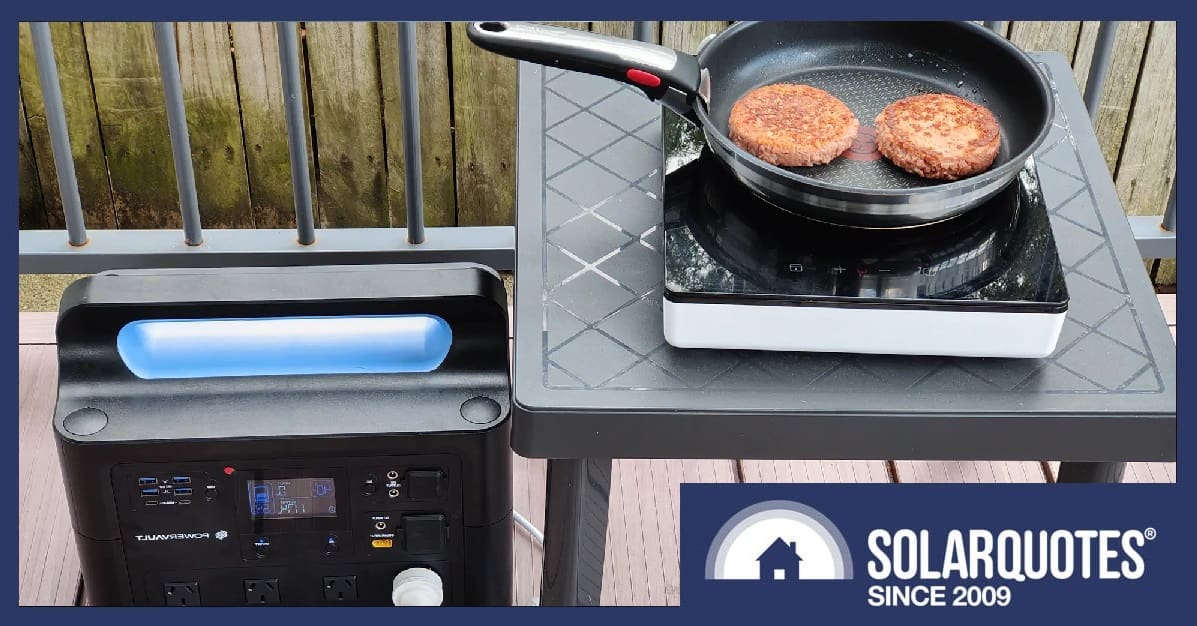
Portable power stations can provide a more affordable solution for backup power during outages, compared to conventional home batteries like the Tesla Powerwall.
Home battery storage works well with solar power to reduce your power bill. However, a Tesla Powerwall home battery will cost about $15,500, including installation.
But can you spend a fraction of that and still power your home essentials through short blackouts using ‘portable power stations’?
Portable Power Stations
Instead of brands like Tesla, BYD and Sungrow, which dominate the fixed home battery storage market, the big players in the portable battery station sector are quite different, such as Anker and Ecoflow.
Portable power stations are not permanently connected to your home switchboard like a Tesla Powerwall.
They can be placed anywhere in your house and taken elsewhere via your car boot to use on holiday, at a picnic or worksite (as long as it doesn’t rain as they are not waterproof).
Think of them as a really big version of the power bank many people keep in their backpacks or handbags to recharge a flat smartphone battery.
The key differences are that a portable power station has:
- much more battery storage capacity,
- a wide variety of power outlets, not just a USB port and
- can usually be recharged from either an ordinary power socket, a 12V power supply such as your car or solar panels connected directly via XT-60 connector.
Real Life Portable Power Station Test
My local grid distributor, Ausgrid, unintentionally created the perfect opportunity to test how a portable home battery would handle an extended blackout by warning me of an 8-hour planned outage while they worked on the power poles in my street.
Luckily, Anker lent me a 757 PowerHouse portable battery to test during this grid power outage.
At a hefty 19.9kg, the $1,800 Anker 757 PowerHouse is at the very limit of what can be truthfully called portable.
I barely managed to carry it from the front of the house to the kitchen/dining area at the back. The hefty weight would have been easier for two people to manage.
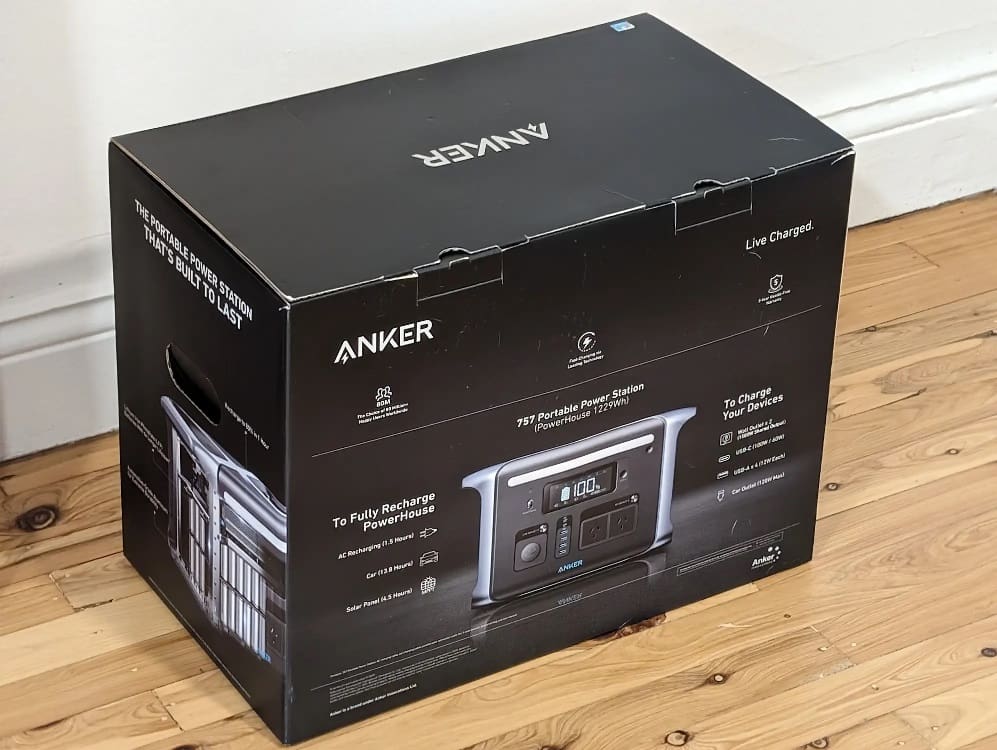
The Anker 757 PowerHouse weighs 19.9kg, testing the limits of what is considered “portable.”
It is rated to last 3000 battery cycles and still maintain 80% capacity. It has a 5-year warranty and many outlets (2 AC ports, 4 USB-A ports, 2 USB-C ports, and a 12V socket).
Large capacity units such as the 757 PowerHouse have the potential for dealing with brief blackouts, like the recent unexpected evening power cut in Western Sydney, and for much longer hours-long grid electricity disruptions and blackouts experienced by some parts of Australia.
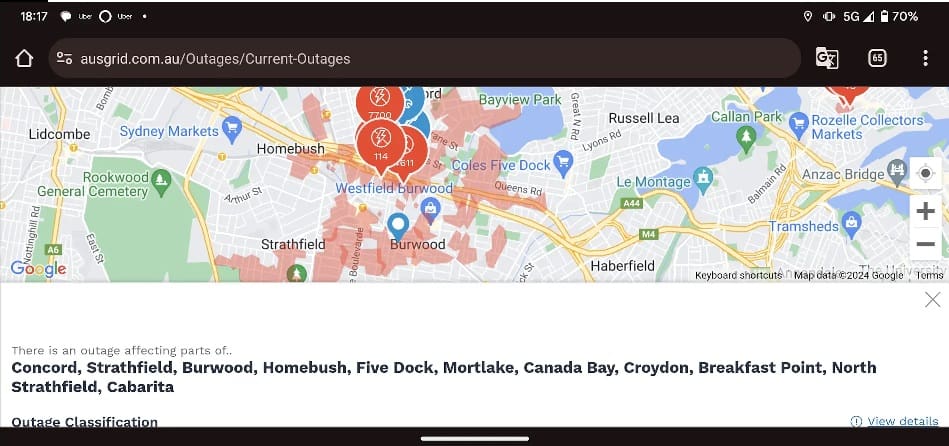
Unscheduled Ausgrid outages across Sydney’s west.
My home has almost 10kW of Jinko solar panels paired with an 8kW Sungrow inverter, but these could not assist because the Ausgrid planned outage started well after sunset.
I plugged our relatively new 520L fridge freezer into the 757 PowerHouse a minute after the outage started.
By dawn the next day, the food in our fridge was still pristine. The battery capacity only fell to 47% between 9:20 pm – 5:22 am when I woke up and plugged the fridge back into its usual wall power socket as the blackout had ended.
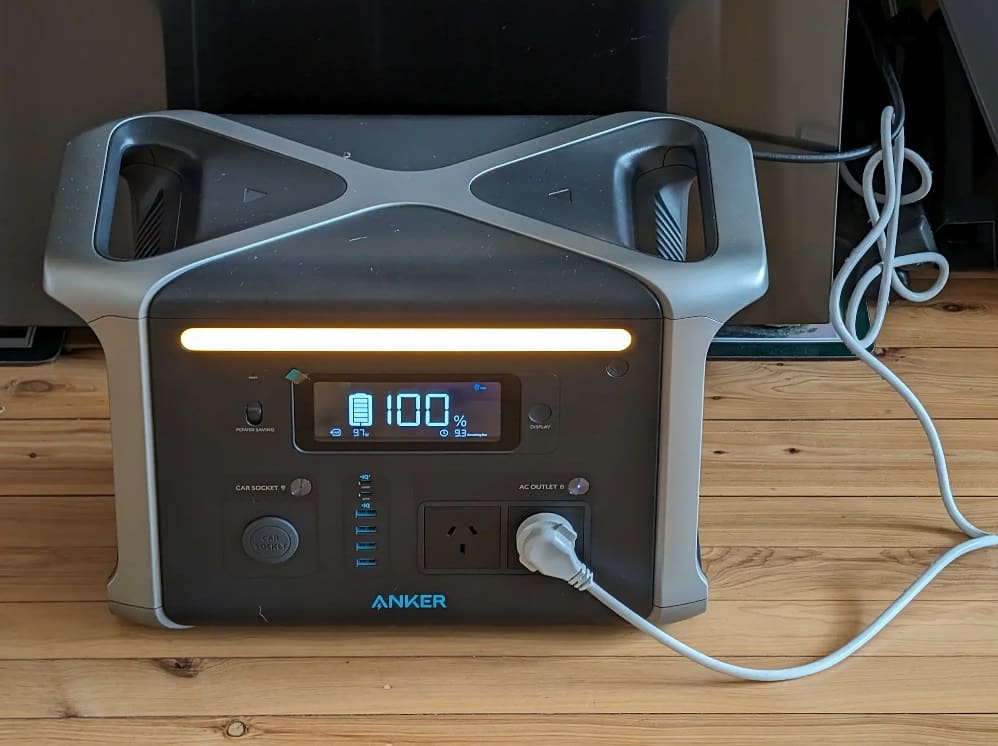
My fridge is plugged into the Anker 757 PowerHouse.
Lessons Learnt
I reckon if I had plugged the fridge into the 757 PowerHouse much earlier in the day and let it acclimatise while the battery was in UPS auto switchover mode plugged into a wall socket, then the total battery percentage depleted during the 8-hour outage would’ve been even less, as the fridge would’ve been in a steady low-use state by the time grid power got cut.
My Power Sensor monitor shows that our fridge typically uses 0.8-0.9kWh per day. So, the fridge could have functioned plugged into the 757 PowerHouse for just over a day if it had been in a lower steady-state power draw at the time of the blackout.
Smaller, more easily carried portable power stations can be used for many tasks away from home. My friend Stan uses his 256Wh Ecoflow River while camping overnight during long road trips to recharge his drone and other portable gadgets.
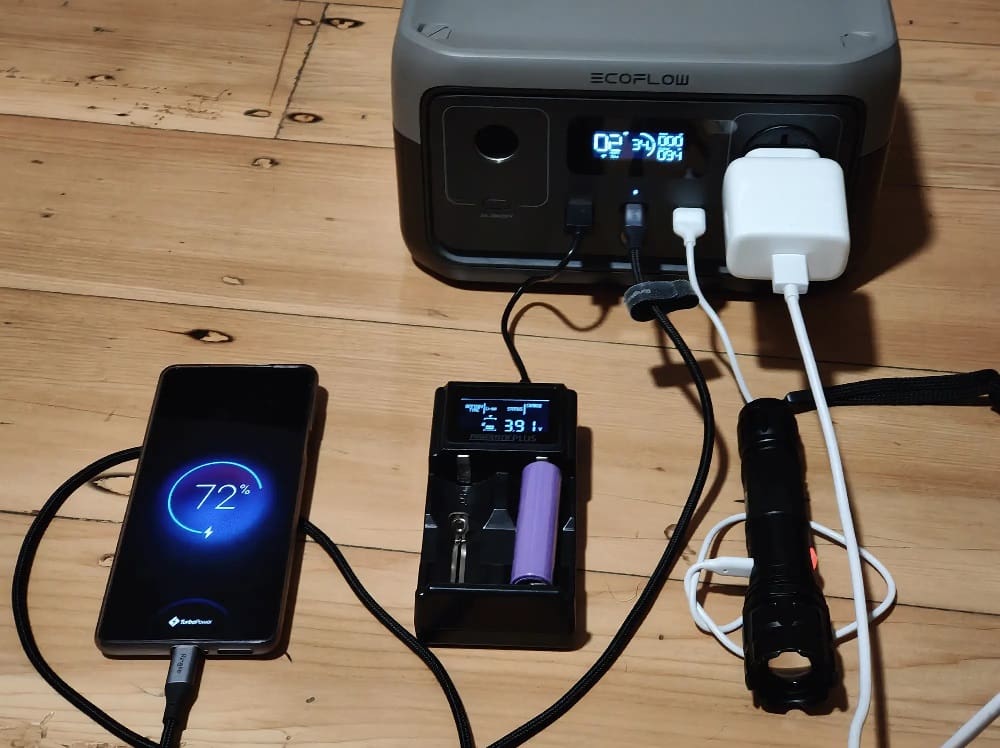
The 256Wh Ecoflow can power several mobile devices at the same time, making it ideal for camping.
When I tested induction cooking with the Laser NRGVault 1500 last year, the battery remaining time fluctuated as the power draw went up and down, from a low of 41 minutes to a high of 1.4 hours. This means you can use a portable power station with at least a 1kWh battery for portable cooking, but it will deplete the battery quickly.
Tasks like induction cooking that requires a power draw of several hundred or 1000kW or more would require you to cart multiple large-capacity power stations along in your car boot for an electrified glamping meal.
Realistically, running an induction cooktop from a vehicle-to-load (V2L) compatible electric car such as the Kia EV6 or MG4 would be more practical as these cars have much larger battery capacities of 50kWh – 77kWh depending on the model.
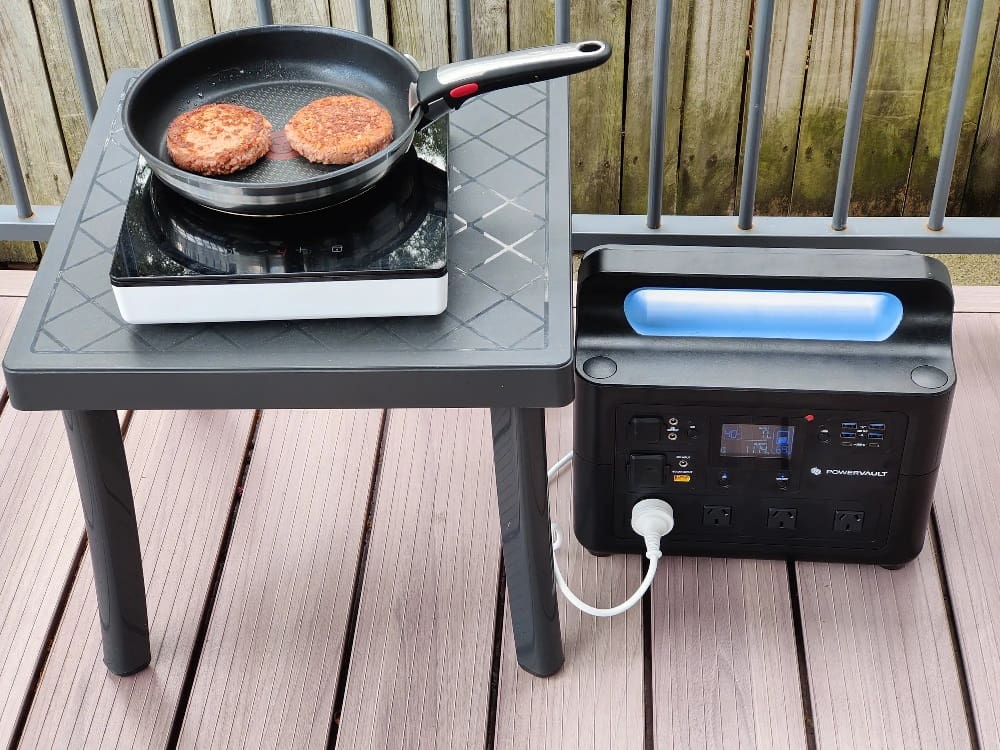
The NRGVault PV1500 can even power a portable induction cooktop.
Portable Power Station Buyer’s Guide
Specifications for the models mentioned in this article are included below to show that just because 2 batteries have similar storage capacity doesn’t mean they have similar prices, weights, warranties, or other key features.
| Model | Max Rated Power Output | Max Rated Power Input | Storage Capacity (kWh) | Price | Weight (kg) | $/kWh | Warranty (Years) | Warranted Charge Cycles (til capacity drops to 80%) |
|---|---|---|---|---|---|---|---|---|
| Anker 757 PowerHouse | 1500W | 1000W | 1.229 | $1,799.95 | 19.9 | $1,464.56 | 5 | 3000 |
| LASER PV1500 | 1500W | 1000W | 1.228 | $1,500 | 15.8 | $1,221.50 | 3 | 2500 |
| Ecoflow River 2 | 300W | 360W | 0.256 | $399 | 3.5 | $1,558.59 | 5 | 3000 |
| BLUETTI EB3A | 600W | 430W (AC+Solar) | 0.268 | $449 | 4.6 | $1,675.37 | 2 | 2500 |
The underlying technology used in the better quality portable battery stations is LiFePO4 / Lithium Iron phosphate (LFP), which is considered safer than Nickel Manganese Cobalt (NMC) batteries, which contain the controversial element Cobalt.
If you need to recharge quickly, check the promised time. Plugged into a standard household power socket, the 757 PowerHouse can recharge from flat to 80% in just 1 hour, which is an impressive half an hour faster than a similar capacity Laser NRGVault power station that I tested last year.
Check the promised number of battery cycles the manufacturer promises. As an example, my small Ecoflow River 2 (256Wh) is rated to 3000+ battery cycles before capacity drops to 80%, whereas competitor BLUETTI EB3A is only rated to 2500+ battery cycles.
These gadgets are not cheap, so I suggest choosing one with a long warranty. For example, the Anker 757 PowerHouse has a 5-year warranty, whereas a competing brand of similar capacity, the Laser NRGVault 1500, has only a 3-year warranty.
Buy a portable power station in person or online from a reputable Australian retail or manufacturer-direct store. This is not the kind of gadget you want to buy from Aliexpress.
Sales are relatively regular, e.g., EOFY, Christmas, etc., so if you can wait until then, you can spend less money on a good portable power station.

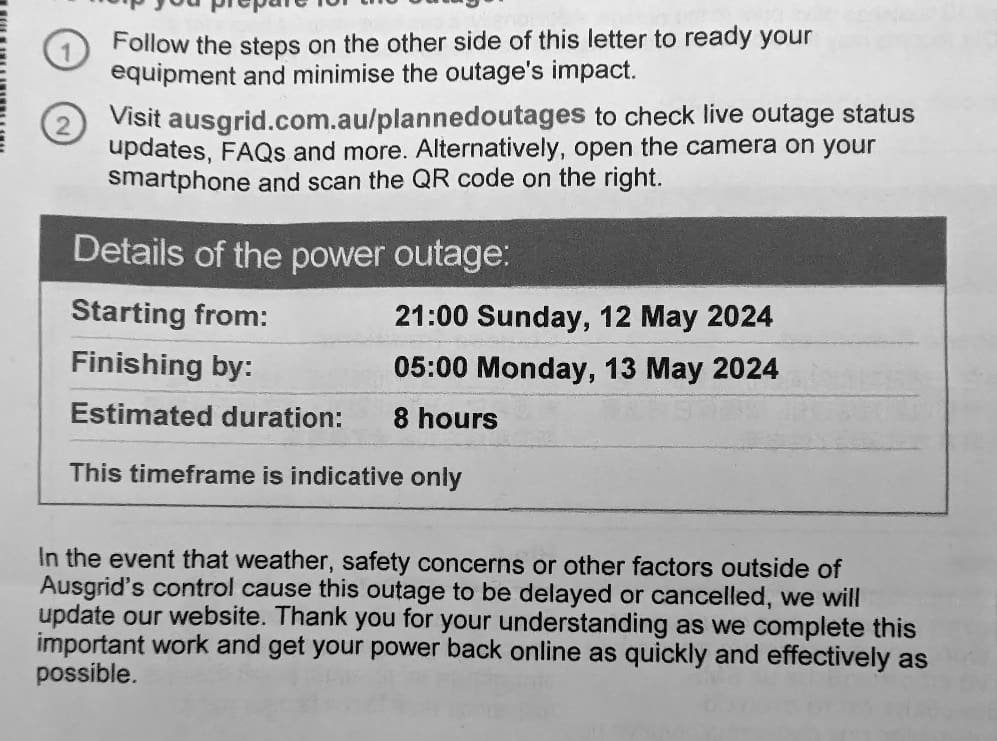
 RSS - Posts
RSS - Posts



The “portable power station” idea is definitely moving us in a good direction – now we need a means by which to use the solar panel power generated when the grid is unavailable – any ideas on achieving this objective?
Hi Textminer,
It really depends on the device. A solar panel and MPPT regulator will easily charge a battery if there’s a suitable input plug, however it needs to be well controlled with appropriate voltage settings. Whether the particular brand or model has an inbuilt solar regulator or what sized panel it might cope with is something that would need to be checked carefully.
yes, thanks Anthony – i probably should have written “using the existing roof-top solar panels. It is rather irritating that there is no solution to this issue at present.
Thanks, this is interesting and useful. Just wondering, with regard to your comment about solar panels connected directly via XT-60 connector…we had to remove fully function sunpower 200w panels from our roof (because the fronius inverter died again, and modern inverters won’t play with the sunpower PVs), and are looking for a good use for these panels. By connecting directly with the XT60, can we avoid having an inverter? Any other ideas for the panels warmly welcome (we have an EV, but not home battery).
These ‘power stations’ are an ideal way to utilise older panels.
The specs you need to keep an eye on are the combined Open Circuit Voltage needs to remain under the generator limit by about 10%.
Connected in series the OCV of each panel needs to be added up.
These kits usually come with some cables.
Hey – Stan with the EcoFlow here – great article Neerav.
I do wish that I had got up model slightly to something around 500 or 600w as my little one is just too small to run the fridge etc It is perfect for drones and my phone/laptop etc and it tucks away nicely.
Although I realize only a much larger full size portable battery, say 1000w, would do my car fridge for any length of time but I don’t think I would like to have something that big in my passenger footwell.
I do wish my Polestar 2 had V2L but I am sure my next Polestar will!
My modem/router tends to have a hissy fit if the power to it goes off and all the settings need to be restored to factory default and then changed back to what all the smart devices, lights, plugs, TV, etc are programmed for. Even with Sungrows lightning quick change over to battery in a power outage it is still not an UPS. Have thought that if modem was connected to one of these devices, or any LIFEPO battery amd inverter, which was charged from a 10A gpo, my issue would be solved as it would then act as an UPS and be fully charged from the house supply whether solar, battery or grid.
Search for 12v 3a UPS – likely the solution you need. For ~$50 you they are effectively a portable battery pack that provides power while charging. Can power NBN or wifi modem for 4-8hrs.
My Sungrow backup setup doesn’t cover the power point circuit the internet is on (it’d effectively be whole house backup if it did). Few of these devices was way cheaper than a more multipurpose power station and easier to hide.
I’ve got a Fronius+BYD battery, which does not do immediate switchover (takes around 30 sec). I bought a couple of cheap ($100) UPS, one which handles my router+nbn+server, the other has our desktop (the rest of our computers are now laptops).
This has been sufficient, although I’d suggest making sure your UPS can have the beep disabled. We went through dozens of outages in the middle of the night (thanks flying foxes) during summer, and the beeping of the UPS woke us up…
Hi Matthew,
I believe the latest firmware updates have the Fronius changeover time down to around 15 seconds. I think you’ve got the best of both worlds insomuch as the genuine UPS capabilities mean you sensitive electronics aren’t interrupted, but you have an unmissable analogue warning signal when there’s an outage, so you know that curtailing consumption is in order.
Hope it’s working well.
In the Netherlands there is a small home battery you can just plug into an ordinary wall socket, which does backup to and from your house.
Homewizard Plug-In Battery.
https://www.homewizard.com/shop/battery-pre-order/
Is something like this on the horizon for Australia, or do all the portable batteries only able to use their own outlets instead of feeding back into the house?
Hi Ruben,
Australian electrical rules are pretty conservative so I can’t see anything like that ever getting up here. Backfeeding a domestic outlet just isn’t something we do.
Personal experience with portable batteries/inverters has taught me to be sceptical about manufacturer specifications. Always verify before trusting what the brochure states…..
The times I have asked for test certificates has been met with silence…..
Due to ‘reasons’ we can’t install a grid connected battery (yet) so I bought a 3kW Bluetti inverter and 2 x 3kWh expansion batteries and have taken most of our household off grid for the past 2 years with some off grid solar.
Although I think they refer to them as camping batteries, they are far from portable.
We also have a Bluetti AC200Max which has a 2200W inverter and 2kWh of storage. This unit could be considered ‘portable’ with some help to lift it.
I think these solutions could be an option for those who don’t own a roof and for those worried about BLACKOUTS!!!
Hi Rod, I have exactly the same set-up as you : Bluetti AC300 + 2 X B300 and a AC200MAX. They happily run 80% of my home every night and charge from my rooftop solar array by day as needed. It’s as close as I can get to off grid in surburbia. Very happy with Bluetti.
Warren & Rod – the is good news – Would you be willing to share the wiring set-up you have for integrating the bluetti into the house circuits and especially how the charging has been arranged. Can you use your solar panels to charge bluetti during a grid outage, and if yes, how is this accomplished? – this would be a really useful advice. Perhaps Anthony Bennet can write up one of his rather useful and informative articles on this. It seems we cannot wait for the ‘solar industry’ to move such things forward as they are too busy doing mundane things like taking our money for stuff that needs to be changed/replaced within a couple of years if one wants to expand the system. Our 28 panel Enphase IQ7 micro inverter system installed in October 2021is already at the point where any changes to expand capacity requires (apparently) lots of stuff to be changed/replaced, wasting the previous investment and paying over for the ‘new’ stuff. And then there are constant ‘rule’ changes to consider (we live in Perth/WA) to negotiate. The ‘solar industry’ seems to rather immature.
Hi Textminer,
Like a lot of things in this modern world, solar moves quickly as technology changes, there’s an S curve of adoption and a massive energy system transition afoot.
Lobbing rocks at the “solar industry” for taking people’s money sort of ignores the fact that the rules are changing all the time; because they have to. The entire system will fall over if it’s not carefully managed but believe me, solar companies aren’t banging the drum looking for more things to comply with. It’s a highly regulated space with products that change all the time.
If you want simple, something that’s not going to be obsolete, then bricklaying might be a good option but any electrical industry is dealing with a permanent state of flux.
Hi Textminer,
There are a couple of Bluetti FB groups with lots of info and different setups. Also lots of Youtubes.
Many people use a transfer switch. My solution is less elegant and would be frowned upon here 😉 My solar is off grid but you could charge with your existing solar via a wall plug and run appliances during a blackout or as part of load shifting.
Bluetti also has a new whole house battery EP760 that can be run on or off grid and looks to be good value to me.
Good to hear another happy Bluetti user. Yes I am so happy I found this solution for our situation.
All batteries 100% today in Adelaide and the AC running flat out for FREE.
Go Bluetti! We have a Bluetti AC70 paired with an Ecoflow 160w panel and use it for powering our camping fridge, phones, rechargeable lights etc while camping. It’s a great little battery and more than enough for our needs.
It’s also comforting to know that should we experience a power outage we can use it to keep our camping fridge going and the fans on while it’s being charged by the sun.
We don’t yet have solar on the roof but are looking at taking advantage of the new HEUF loans with Plenti (NOT the interest free variety). We have an EV we currently slow-charge overnight which works just find for us but we are looking at installing a dedicated charger for it once we get our solar and battery sorted.
I mentioned I was interested in using a Solar Quotes approved installer but not sure if it’s possible. Apparently, we are limited to installers that are approved by the HEUF scheme and Plenti:
“Please also note that the vendor you proceed with needs to be approved by the NETCC and needs to be accredited with Plenti.”
Question:
Do you know if these installers are reliable? I don’t know which ones are approved for Darwin where we are.
Hi Leanne,
Be aware that the NETCC is meaningless marketing tool, an expensive pay-for-play blue tick. Many in the solar industry argue it’s against the trade practices act as it’s a limit placed on business by a private company pretending to be a statutory authority (The Clean Energy Council)
The best of the best and the worst of the worst have it because it’s awarded to anyone who’s cheque will clear. It offers zero consumer protection over and above Australian Consumer Law.
Solar Quotes offer a third party guarantee which really does promise you’ll get a great job.
https://www.solarquotes.com.au/installation-guarantee/
https://www.solarquotes.com.au/installers/cities/darwin/
Tasks like induction cooking that requires a power draw of several hundred or 1000kW or more would require you to cart multiple large-capacity power stations along in your car boot for an electrified glamping meal.
Really, a MW or more???
🙂
Sam
Hi Sam,
What’s 3 zeroes between friends?
In fact you can buy 2kW induction cooktops in many places, and they’re popular with campers, who are sick of gas stoves that can’t cope with the wind.
Modern inverters and lithium batteries make it practical to build a caravan that doesn’t use gas at all now.
I tech world and bluetti both do 2 kw versions charging from 12v ,240v , or solar input , fairly pricey but both have UPS mode change over about 2 milliseconds.
I think around 23kg being promoted for caravaners as an alternative to a generator
With the battery power supply I would like to know how long the charge lasts after an initial charging without any use. I have a couple of car battery jumpers that I forget to charge at regular intervals since I do not need them that often. I have found that on one at least the charge levels drops below 80% if it has been stored for a period of over 6 months.
With this type of item as an emergency backup you might keep it in the back of the house of shed for use when needed and it would not be kept on charge. So how long would one of these backups hold a charge to at least 80% after a long term storage. Also what would be the charging cycle to keep the unit happy.
Good question Tim
Like any Lithium battery whether in a jump starter or a large portable power station you should use and charge it occasionally to keep the device alive.
You can’t just leave devices like these in a corner fully charged and unused for many months without potential deterioration or damage occurring.
Another option for some may be a Ryobi Power Station battery pure sine wave inverter that uses 36V power tool lithium batteries. Nominally 1600W max load, listed at $899. If you already have the detachable batteries (e.g. for lawn mower), it can be good value for occasional use; otherwise if you have to buy batteries, probably more expensive than other options. I haven’t seen any information on the number of cycles Ryobi warrants its batteries for, so might be best for occasional use. We used it successfully for several hours to run fridge and freezer during an unplanned power outage.
It’s an impressive unit. But the real comparison is with a traditional ICE generator.
I have a little Honda 2kVA gennie. It runs up to 8 hours on a tank of fuel, or a week with a couple of Jerry cans.
We have medical equipment needed for an immobile family member. The Honda has saved us a couple of times now.
I’d rather buy a larger generator and transfer switch than a power wall battery. Given the Melbourne winters it’s risky to rely just on solar for any extended outages.
I have about 1000 18650 20700 and 21700 lithium batteries. Has anyone made their own battery solution? All I need now is done old solar panels to connect.
I’ve been connecting them up as 13S4P to get 48V at about 400Wh.
Does anyone have any advice? Has anyone done something similar?
My brother said that when they all go up (lithium battery fire) they should be able to see it from Adelaide 80km away!
Hi Phillip,
There’s a Facebook group for recycled 18650s called “DIY Powerwall”
Some of them are amazing for good and bad reasons but it’s a hobby that’s dying out as larger new batteries become cheaper.
Be careful, house your hobby in a detached shed, and be aware nobody will insure it.
You’ll struggle to find an electrician who will go anywhere near it too.
However it’s a good recycling outcome.
Can the Anker run power tools?
Would you be willing to review/compare the Redarc100Ah GoBlock Portable Dual Battery System?
https://www.redarcelectronics.com/au/100ah-goblock-portable-dual-battery-system
In an off grid home, my old batteries and inverter (24v setup) have died.
All is well when I run the generator.
Can I simply plug these power banks into the wall 240v to charge when genny is running?
Is there a 12-24v output that can be connected to an inverter input to make 240v?